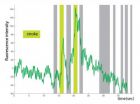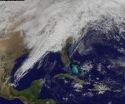(Press-News.org) A pair of University of Colorado Cancer Center studies published this month show that the milk thistle extract, silibinin, kills skin cells mutated by UVA radiation and protects against damage by UVB radiation – thus protecting against UV-induced skin cancer and photo-aging.
"When you have a cell affected by UV radiation, you either want to repair it or kill it so that it cannot go on to cause cancer. We show that silibinin does both," says Rajesh Agarwal, PhD, co-program leader of Cancer Prevention and Control at the CU Cancer Center and professor at the Skaggs School of Pharmacy and Pharmaceutical Sciences.
The first study, published in the journal Photochemistry and Photobiology worked with human skin cells subjected to UVA radiation, which makes up about 95 percent of the sun's radiation that reaches Earth. The Agarwal Lab treated these UVA-affected cells with silibinin. With silibinin, the rate at which these damaged cells died increased dramatically.
"When you take human skin cells – keratinocytes – and treat them with silibinin, nothing happens. It's not toxic. But when you damage these cells with UVA radiation, treatment with silibinin kills the cells," Agarwal says, thus removing the mutated cells that can cause skin cancer and photo-aging.
Specifically, the study shows that pretreatment with silibinin resulted in higher release of reactive oxygen species (ROS) within the UVA-exposed cells, leading to higher rates of cell death.
The second study, published this month by the same authors in the journal Molecular Carcinogenesis shows that instead of beneficially killing cells damaged by UVA radiation, treatment with silibinin protects human skill cells from damage by UVB radiation, which makes up about 5 percent of the sun's radiation reaching Earth.
Again, remember Agarwal's suggestion that the prevention of UV-induced skin cancer can happen in two ways: by protecting against DNA damage or by killing cells with damaged DNA. With UVA, silibinin kills; with UVB, it protects, in this case by increasing cells' expression of the protein interleukin-12, which works to quickly repair damaged cells.
"It has been 20 years of work with this compound, silibinin," Agarwal says. "We first noticed its effectiveness in treating both skin and solid cancers, and we now have a much more complete picture of the mechanisms that allow this compound to work."
Agarwal and colleagues continue to test the effectiveness of silibinin in cancer prevention and treatment in cell lines and mouse models, and are working toward human trials of silibinin-based therapeutics.
### END
Silibinin, found in milk thistle, protects against UV-induced skin cancer
Studies show that silibinin protects against UVB damage and kills skin cells damaged by UVA
2013-01-31
ELSE PRESS RELEASES FROM THIS DATE:
Prostate cancer study tracks long-term urinary, sexual and bowel function side effects
2013-01-31
A new study comparing outcomes among prostate cancer patients treated with surgery versus radiotherapy found differences in urinary, bowel and sexual function after short-term follow-up, but those differences were no longer significant 15 years after initial treatment.
The study, led by first author Matthew Resnick, M.D., instructor in Urologic Surgery, Vanderbilt University Medical Center, was published in the Jan. 31 issue of the New England Journal of Medicine.
From Oct. 1, 1994, through Oct. 31, 1995, investigators enrolled men who had been diagnosed with localized ...
Checking out open access
2013-01-31
This press release is available in French.
Montreal, January 20, 2013 – From Wikipedia to shareware, the Internet has made information and software more widely available than ever. At the heart of this explosion is the simple idea that information should be open and free for anyone. Yet with publishers charging exorbitant fees for subscriptions to academic journals, university libraries are struggling to keep up.
Writing in the Journal of Academic Librarianship, Concordia collections librarian Geoffrey Little says that a key way to meet that challenge is through ...
Sorting out stroking sensations
2013-01-31
PASADENA, Calif.—The skin is a human being's largest sensory organ, helping to distinguish between a pleasant contact, like a caress, and a negative sensation, like a pinch or a burn. Previous studies have shown that these sensations are carried to the brain by different types of sensory neurons that have nerve endings in the skin. Only a few of those neuron types have been identified, however, and most of those detect painful stimuli. Now biologists at the California Institute of Technology (Caltech) have identified in mice a specific class of skin sensory neurons that ...
Rejuvenation of the Southern Appalachians
2013-01-31
Boulder, Colorado, USA – In the February 2013 issue of GSA Today, Sean Gallen and his colleagues from the Department of Marine, Earth, and Atmospheric Sciences at North Carolina State University take a new look at the origin of the Miocene rejuvenation of topographic relief in the southern Appalachians.
Conventional wisdom holds that the southern Appalachian Mountains have not experienced a significant phase of tectonic forcing for more than 200 million years; yet, they share many characteristics with tectonically active settings, including locally high topographic relief, ...
Empathy and age
2013-01-31
According to a new study of more than 75,000 adults, women in that age group are more empathic than men of the same age and than younger or older people.
"Overall, late middle-aged adults were higher in both of the aspects of empathy that we measured," says Sara Konrath, co-author of an article on age and empathy forthcoming in the Journals of Gerontology: Psychological and Social Sciences.
"They reported that they were more likely to react emotionally to the experiences of others, and they were also more likely to try to understand how things looked from the perspective ...
UNC scientists unveil a superbug's secret to antibiotic resistance
2013-01-31
Worldwide, many strains of the bacterium Staphyloccocus aureus, commonly known as staph infections, are already resistant to all antibiotics except vancomycin. But as bacteria are becoming resistant to this once powerful antidote, S. aureus has moved one step closer to becoming an unstoppable killer. Now, researchers at the University of North Carolina at Chapel Hill have not only identified the mechanism by which vancomycin resistance spreads from one bacterium to the next, but also have suggested ways to potentially stop the transfer.
The work, led by Matthew Redinbo, ...
Binge drinking increases risk of Type 2 diabetes by causing insulin resistance
2013-01-31
Binge drinking causes insulin resistance, which increases the risk of Type 2 diabetes, according to the results of an animal study led by researchers at the Diabetes Obesity and Metabolism Institute at the Icahn School of Medicine at Mount Sinai. The authors further discovered that alcohol disrupts insulin-receptor signaling by causing inflammation in the hypothalamus area of the brain.
The results are published in the January 30 issue of the journal Science Translational Medicine.
"Insulin resistance has emerged as a key metabolic defect leading to Type 2 diabetes ...
Mount Sinai launches clinical trial to treat chronic pulmonary sarcoidosis
2013-01-31
Patients are currently being enrolled in the first clinical trial to investigate the efficacy of immunological therapy for chronic pulmonary sarcoidosis. The trial is being conducted by researchers at the Icahn School of Medicine at Mount Sinai.
Mount Sinai has the largest Sarcoidosis Service in the world and is one of only two institutions in the country participating in the trial; the other is the University of Cincinnati. Mount Sinai is a National Institutes of Health Center of Excellence for research in sarcoidosis.
"The current standard treatment for chronic pulmonary ...
New semiconductor research may extend integrated circuit battery life tenfold
2013-01-31
Researchers at Rochester Institute of Technology, international semiconductor consortium SEMATECH and Texas State University have demonstrated that use of new methods and materials for building integrated circuits can reduce power—extending battery life to 10 times longer for mobile applications compared to conventional transistors.
The key to the breakthrough is a tunneling field effect transistor. Transistors are switches that control the movement of electrons through material to conduct the electrical currents needed to run circuits. Unlike standard transistors, which ...
Satellite image shows eastern US severe weather system
2013-01-31
A powerful cold front moving from the central United States to the East Coast is wiping out spring-like temperatures and replacing them with winter-time temperatures with powerful storms in between. An image released from NASA using data from NOAA's GOES-13 satellite provides a stunning look at the powerful system that brings a return to winter weather in its wake.
On Jan. 30 at 1825 UTC (1:25 p.m. EST), NOAA's GOES-13 satellite captured an image of clouds associated with the strong cold front. The visible GOES-13 image shows a line of clouds that stretch from Canada ...
LAST 30 PRESS RELEASES:
New Zealand researchers identify brain link to high blood pressure
New research confirms people with ME/CFS have a consistent faulty cellular structure
Hidden cancer risk behind fatty liver disease targets
Born in brightness, leading to darkness
Boron-containing Z-type and bilayer benzoxene
Hong Kong researchers break the single-field barrier with dual-field assisted diamond cutting
Work hard, play hard?
Wood becomes smart glass: Photo- and electro-chromic membrane switches tint in seconds
The Lancet: COVID-19 vaccine hesitancy decreased over time, though mistrust persists among certain groups, study of over 1 million people in England suggests
Psychosis patients ‘living in metaphor’ -- new study radically shifts ideas about delusions
Clinical trial in Ethiopia targets the trachoma scourge
Open-sourcing the future of food
Changes in genetic structure of yeast lead to disease-causing genomic instabilities
UC San Diego Health Sciences Grant Writing Course helps launch successful research careers
Study: Many head and neck cancer trials end early. Why?
Tufts vice provost for research named Foreign Fellow of Indian National Science Academy
New model improves prediction of prostate cancer death risk
Two wrongs make a right: how two damaging variants can restore health
Overlooked decline in grazing livestock brings risks and opportunities
Using rare sugars to address alcoholism
Research alert: New vulnerability identified in aggressive breast cancer
Ruth Harris honored with SSA Distinguished Service Award
Treasure trove of data on aging publicly accessible
Trees4Adapt project to address risks from climate change and biodiversity loss through tree-based solutions
Nature Communications study from the Lundquist Institute identifies molecular mechanism underlying peripartum cardiomyopathy
Pennington Biomedical’s Dr. Gang Hu appointed to NIH Reproductive, Perinatal and Pediatric Health Review Group
World-first project shows great promise to treat low eye pressure
New technique puts rendered fabric in the best light
Brain cancer digital twin predicts treatment outcomes
Cat disease challenges what scientists thought about coronaviruses
[Press-News.org] Silibinin, found in milk thistle, protects against UV-induced skin cancerStudies show that silibinin protects against UVB damage and kills skin cells damaged by UVA

